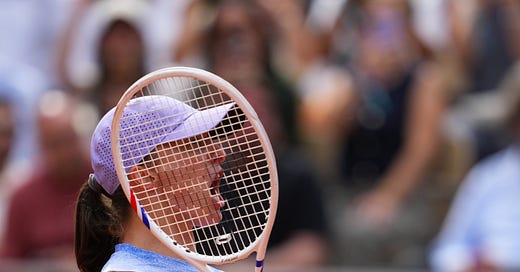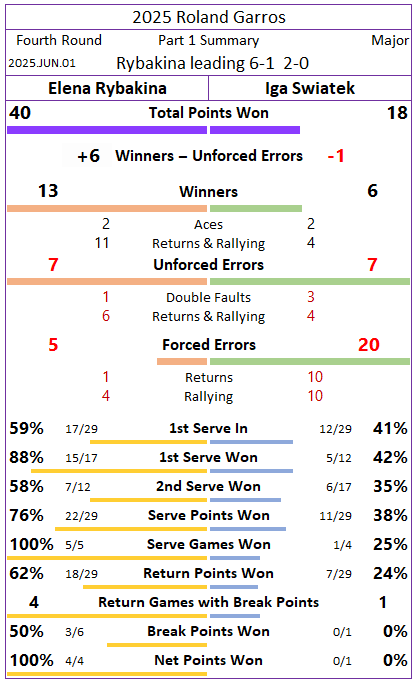Roland Garros: Elena Rybakina vs Iga Swiatek fourth round analysis
A strategical adjustment spearheading a comeback win that may very well define the rest of Swiatek's 2025 season
Without a tournament win since last year’s French Open, Iga Swiatek (WTA #5) arrived in Paris the most vulnerable she has ever been entering any of her Roland Garros title defenses. Would the recent doubts in her game grow at the tournament where expectations and pressure reach their highest? Or would a return to a sacred ground inspire the Pole to regain her once unbeatable clay form?
Opposite possibilities that must have crossed everyone’s mind during a captivating fourth round blockbuster between Swiatek and Elena Rybakina (WTA #12).
For the first 9 games of the contest, it sure looked like the defending champion would bow out in quick and spectacular fashion — even if her level wasn’t as bad as the score suggested. Then Wim Fissette dropped a simple coaching advice that kickstarted an extraordinary turnaround. So efficient in its trickle-down effect that, by the end of the match, it had Swiatek reminding the world once again of the formidable force she can be on the red dirt.
In this post, you will find a breakdown of Rybakina’s dominant start, when and what Fissette urged Swiatek to do and all the numbers showing how much the match changed afterwards. Hope you follow along and enjoy.
Part 1 - Rybakina builds 6-1 2-0 lead
Rybakina started out playing perfect first-strike tennis.
With lights-out serving and ultra aggressive returns, the Kazakh stormed through the opener and back-to-back love games at the start of the second set while denying Swiatek any sort of rhythm.
Out of 17 1st serves Rybakina landed during this stage of the match, she won 15 points (88%) — as many as 11 only requiring a serve to get the job done. Rounding out a lethal combination, the 12-seed was also all over Swiatek’s deliveries, ripping 5 winning returns and setting up 4 “return+1” winners on her way to 3 breaks of serve.
📺 source: Eurosport / Max
Over the first 9 games, Rybakina’s early-offense mindset and impeccable execution led to an average rally length of 2.43 valid shots per point. A pair of rallies reached 6 shots, both won by Rybakina at the net; otherwise, all other points ended sooner.
Tremendously efficient on her strikes, the Kazakh built a huge 18-point advantage in short points (34 to 16) and also took 6 of 8 medium rallies played.
Apart from a poor 41% of 1st serves made and 3 double faults, Swiatek’s level wasn’t that bad per se. It would be nearly impossible to predict how the scoreline was developing just looking at the Pole’s winners-to-unforced errors differentials:
+1 at the end of the first set (6 winners, 5 UEs)
still a fairly acceptable -1 after the first 9 games (6 winners, 7 UEs)
But with Rybakina playing at a sky-high level, Swiatek was unable to dictate. Constantly smothered by the massive shots coming from other side of the net, the defending champion accumulated 20 forced errors (10 on returns and 10 while rallying) during the first 58 points of the match.
Forehand Performances (first 9 games)
Rybakina: 6 winners / 4 UEs + 2 FEs = 0
Swiatek: 3 winners / 1 UEs + 13 FEs = -11
Backhand Performances (first 9 games)
Rybakina: 5 winners / 2 UEs + 3 FEs = 0
Swiatek: 1 winner / 3 UEs + 7 FEs = -9
[Upgrade your subscription and keep reading. Don’t stop now! Below the line you will find Fissette’s advice to Swiatek, how she implemented it and everything that changed in the match afterwards. Plus, we share our usual extensive match data set.]





